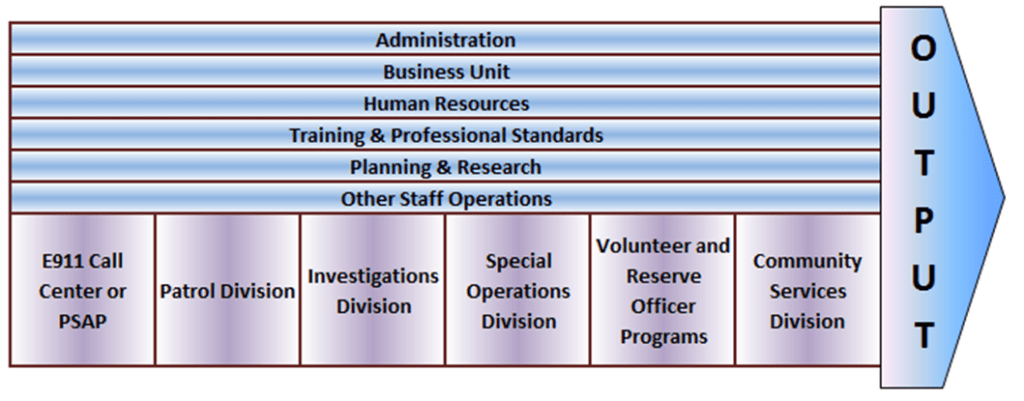Never Break The Chain

A chain is only as strong as its weakest link….
Value. We all know what value looks and feels like. Every time we make a purchase or pay for a service, we want the best value we can get for our money. If we get the value we want and expect, we come back for more and tell a few friends. If we come up short handed, we don’t go back and we tell everyone who will listen.
As a professional police department, the basis of our value proposition should recognize this simple customer/provider relationship. We do not want to provide services by simply answering calls. We could do the bare minimum, given we are the monopoly in the local peace and order business. Instead, we want to put our best foot forward and do everything we can to provide services that are valued by the community. Some of the value-adding mechanisms are transparent and readily visible, such as expectations with regard to how officers and police employees communicate and interact with the public. But many value-adding activities are subtle. Examples of these activities that are in the background can be found in the efficiency of police department functions, and how well those functions play together.
Everything of value that is produced, is produced by organizations that add value at every opportunity as the product or service is developed. Ideally, every activity in the police agency will add value to the services that the citizens in the community (the customers) receive. To determine how well we are doing, we can take a look at the organizational components and operations of the agency in terms of a value chain and analyze the value that each adds.
Based on the work of Michael Porter, a value chain analysis presents a holistic approach to the organization (Solutions: Business Problem Solving by Bolland and Fletcher, 2012). Just as the term chain suggests, all of the operations in a police department are dependent on the strength of one another.
Businesses use this method to help create a competitive advantage in their environment. Police departments may not be in competition for business, but they are certainly competing for trust and support from the citizens they serve.
To create a visual representation of the department’s value chain, the staff and administration functions are grouped separately from the line and service producing functions.
A police department value chain might look something like this:

The actual functions can be adjusted to suite the department. A reasonable question could be asked: I have an organizational chart, can that be used instead? It can; but organizational charts spider out from central points and do not emphasize the interdependence of the functions of the police department. Remember, we are looking at a holistic view of the entire operation as a whole organism, not the singular parts.
The only big difference between business and police departments with regard to value chain analysis is the consideration of financial costs and profits. While it is true that policing is not making any money, we cannot lose sight of the fact that we have to spend what we have wisely, so there is good reason to look at the return on our investments and identification of opportunity costs.
Now what?
Start looking at the value chain from 36,000 feet, and glide down from there. The value chain identifies the broad categories of roles and responsibilities, and reminds us that operations and functions do not work in silos and vacuums.
Each operation and function will need individual attention, narrowing the focus and mapping process flows in each to make sure there are no hindering constraints and identify the components that are effectively creating value. When looking at the links in the value chain, helpful considerations include:
- Verify that money spent is well spent. Each area should be examined to verify that all of the operations and projects that are in place are subordinated to the mission and strategy of the police department. If explanations as to how a given process or project are related to to the mission of the agency meander and take to long to explain, those items need a little more scrutiny. Make sure that the returns on investments are the best they can be and that time (which is money and opportunity) is being spent on worthwhile ventures that support the current strategic plan.
- Identify and support the dependencies between the functions. Admittedly, this can be difficult in police departments. Fiefdoms, vacuums and silos are not uncommon in the industry; often established and fortified because of individual personalities. Sad? Frustrating? Counter-productive? Absolutely. Find the walls and tear them down.
- Identify opportunities to out-source processes that are bearing down on your personnel resources. The make-or-buy decision can not be made if no one understands what the impact of an in-house operation is having on the organization as a whole. Never steal from Peter to pay Paul, Peter does not like it.
- Check on the morale and motivations of the personnel in each function. Make sure that everyone understands the importance that they play in the operation of the police department. If there is any uncertainty, put your best leaders to work in those areas to get buy in and ownership.
- Be very wary of traditional approaches and processes. The worst philosophy known to man is ‘we’ve always done it this way’. If ‘this way’ really works, leave it alone. But test it thoroughly first.
- Double check to make sure community relationships are developed and cultivated sincerely whenever they are part of a function or operation. That is our bread and butter, where our bottom line can be found.
- Explore the possibility of using Lean, Six Sigma and the Theory of Constraints (TOC) to improve quality and efficiency. This blog will be exploring these in the near future as part of the Process of On-going Improvement. These concepts and combinations of the concepts are geared toward creating value.
So?
All of the links of a given chain usually look alike, and are assumed to be strong. But any chain that is put under stress is going to eventually present a link that was not as strong as we thought. The best way to prevent failures is to regularly inspect the chain closely and make sure each link is intact and is solid.
We can do this in a police department, and create an environment and culture that adds value to the services we offer.
What barriers to value creation have you seen in police departments?
“A relentless barrage of ‘why’s’ is the best way to prepare your mind to pierce the clouded veil of thinking caused by the status quo. Use it often.”
– Shigeo Shingo
